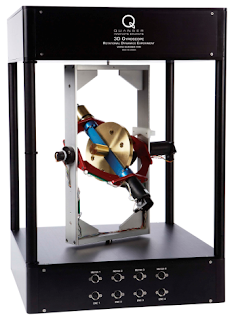 One of the great features of the Quanser 3 DOF Gyroscope is that while all three gimbals are free to rotate in space, each one can be fixed individually upon desire. This allows for many different possible configurations under which the device can be setup and controlled. For example by fixing the outer rectangular frame and the blue gimbal simultaneously, one can control the angle of the red gimbal by changing the speed of the rotor only. This is the classical reaction wheel experiment. Alternatively and as another possible experiment the red gimbal can be fixed, and the angle of the rectangular frame can be controlled by commanding the blue gimbal motor only! Of course the rotor has to be spinning at a certain RPM for this to happen. This experiment is a direct application of the gyroscopic effect.
One of the great features of the Quanser 3 DOF Gyroscope is that while all three gimbals are free to rotate in space, each one can be fixed individually upon desire. This allows for many different possible configurations under which the device can be setup and controlled. For example by fixing the outer rectangular frame and the blue gimbal simultaneously, one can control the angle of the red gimbal by changing the speed of the rotor only. This is the classical reaction wheel experiment. Alternatively and as another possible experiment the red gimbal can be fixed, and the angle of the rectangular frame can be controlled by commanding the blue gimbal motor only! Of course the rotor has to be spinning at a certain RPM for this to happen. This experiment is a direct application of the gyroscopic effect.Using QuaRC, interfacing to sensing and actuating elements of this hardware becomes as easy as dragging and dropping blocks into a Simulink model. Once a controller is designed for any desired configuration of the 3 DOF Gyroscope, real-time control, on-the-fly tuning, and data monitoring can all be done with the help of QuaRC and under the MATLAB environment.
The video below, shows the 3 DOF Gyroscope with its red gimbal fixed. In this configuration the angle of the outer rectangular frame is being controlled by commanding the blue gimbal motor only. The real-time plot shows the commanded signal versus the actual frame angle versus the simulated frame angle.
As another configuration, one can fix the outer rectangular frame and control the red gimbal orientation. The video below shows this configuration with the control signal being applied to the blue gimbal motor only as was the case with the previous configuration. The MATLAB Virtual Reality toolbox can be employed by QuaRC to run a real-time virtual environment simulation of the device in parallel to the actual controller commanding the plant.

No comments:
Post a Comment